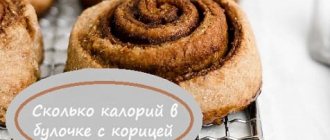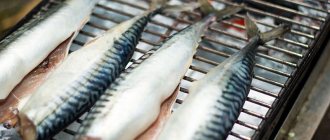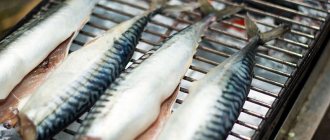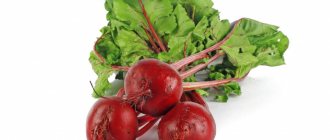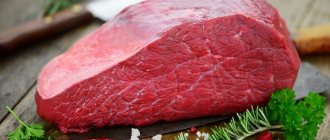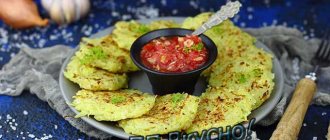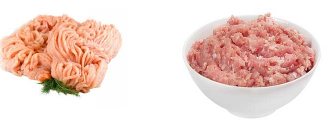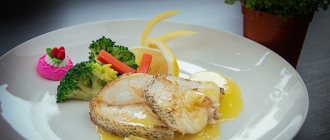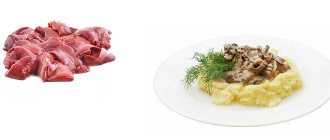Curd bun
Nutritional value of the dish “Curd bun” (per 100 grams):
Calories:
245 kcal.
Proteins:
10.6 gr.
Fats:
3.9 gr.
Carbohydrates:
41.8 gr.
Ingredients and calorie content of the “Curd Bun” recipe
(calorie content and nutritional value are calculated approximately, excluding boiling and frying)
| Product | Measure | Weight, g | Bel, gr | Fat, g | Angle, gr | Cal, kcal |
| cottage cheese 5% | 380 gr | 380 | 65.36 | 19 | 6.84 | 459.8 |
| chicken egg | 4 things | 220 | 27.94 | 23.98 | 1.54 | 345.4 |
| granulated sugar | 8 tbsp. | 200 | 199.4 | 796 | ||
| salt | 0.25 tsp | 2.75 | ||||
| vanillin | 5 g | 5 | 0.01 | 0.01 | 0.64 | 14.4 |
| baking powder | 15 g | 15 | 0.02 | 2.94 | 11.85 | |
| wheat flour | 400 gr | 400 | 36.8 | 4.8 | 299.6 | 1368 |
| Total | 1223 | 130.1 | 47.8 | 511 | 2995.5 | |
| 1 serving | 1223 | 130.1 | 47.8 | 511 | 2995.5 | |
| 100g | 100 | 10.6 | 3.9 | 41.8 | 245 |
- Bakery
- Calories: 200-350
- Proteins: 10-20
- Fat: 40
- Less than 30 minutes
This is a custom recipe, so there may be errors and typos. If you find them, please write them in the comments below the recipe and we will correct them.
Step-by-step recipes with photos from our website are in the “Recipes” section.
How many calories are in buns?
Naturally, the calorie content of buns depends on the type and method of preparation.
Pay attention to this table:
Table of calorie content of buns and nutritional value (BJU) per 100 grams:
| Buns: | Bel, gr. | Fat, gr. | Angle, gr. | Cal, kcal. |
| Puff | 5.8 | 27.2 | 52.0 | 476 |
| With raisins | 7.8 | 6.6 | 67.5 | 361 |
| With apple | 6.5 | 17.0 | 67.0 | 450 |
| With jam | 4.4 | 8.7 | 51.0 | 295 |
| With cottage cheese | 11.3 | 11.4 | 42.0 | 320 |
| With sugar | 6.4 | 12.6 | 41.0 | 258 |
| With poppy seeds | 7.6 | 11.3 | 53.0 | 347 |
| With cinnamon synabon | 4.5 | 14.3 | 56.0 | 361 |
| For tea | 7.2 | 6.2 | 51.0 | 317 |
| Calorie | 7.3 | 9.6 | 62.4 | 363 |
| Otrubnaya | 7.8 | 1.8 | 43.9 | 220 |
| Stolichnaya | 8.4 | 2.2 | 52.8 | 270 |
| 8 cereals | 13.9 | 5.3 | 43.7 | 277 |
| With sesame | 9.6 | 4.2 | 59.5 | 320 |
Baking - calorie table
Baked goods are all products made from dough by baking. Bread is baked goods. A bun or pie with filling is a pastry. Pancakes and pancakes are also baked goods, despite the fact that they are baked not in the oven, but in a frying pan. Baking - calorie table will help you calculate the number of calories you eat with a piece of chocolate cake or a slice of bread at breakfast.
Calories in baked goods - are they really dangerous?
Everyone loves baking. There is no such person who would be indifferent to a fragrant golden brown bun, rich charlotte, chocolate cake or golden brown khachapuri. Few people can muster their will and refuse the coveted treat. And even if several times you find the strength to push away a piece of the coveted pie to drink tea without sugar, after some time you will definitely break down again, enjoy it, and then be tormented by remorse, fearfully counting the number of calories consumed.
In fact, there is no need to torture yourself at all. Moreover, even if you are on a diet, you can indulge in this tasty treat from time to time. There is even a specially developed theory that states that you just need to set yourself one or two days a week when you can consume some extra calories. Provided that on the remaining days you continue to adhere to a moderate diet. So, if on Monday, Tuesday, Thursday, Friday and Sunday you consume an average of 1300 kcal per day, then on Wednesday and Saturday you can easily add 320-400 kcal to them and eat something you really want. It won't do you any harm. The most important thing is not to get carried away and not to organize such a “belly celebration” for yourself too often.
Calorie content of baked goods - buns
Baking can be different - rich and not rich. Butter baked goods, for example, buns, contain more calories due to the fact that baked goods are added to them: a large amount of butter, eggs, milk, sugar. This is what makes the buns especially delicious. Therefore, in the calorie table, such baked goods occupy the top positions. Next to the cream cakes. In Rus' they loved rich pastries and usually prepared them for all holidays. To give a particularly appetizing aroma, special flavorings are usually added to butter baked goods - in particular vanillin, vanilla essence or cinnamon.
The calorie content of butter buns is approximately 340 kilocalories per 100 grams.
But it would be wrong to say that the only harm from baking is extra pounds. In fact, butter dough contains many useful substances that the body needs - vitamins: beta-carotene, vitamins B1, B2, B6, B9, A, E and PP, as well as useful minerals: potassium, calcium, magnesium, phosphorus, iron and sodium. Therefore, eating buns is very healthy. You just need to do this in moderation.
Baking - calorie table
Well, now, to make it easier for you to count the number of calories you eat daily, we want to give you a summary table that shows the calorie content of some of the most common baked goods. You need to understand that the data given in the table reflects the number of calories in standard baked goods, such as those you can buy in a store. If you prepare the baked goods yourself, then their calorie content may differ slightly. Depending on how much of certain products you use.
Comments
Required fields are marked with *.
How many calories are in 1 piece of juicer with cottage cheese? and in 100 grams of product
How to prepare the dish “Sochniki with cottage cheese”
Sochen with cottage cheese is a small flatbread filled with shortcrust pastry in the shape of a semicircle, folded in half. In appearance, it is a cross between a pie and a cookie.
Sochen with cottage cheese, the calorie content of which excludes it from a number of dietary products , is a very tasty treat for tea. Moreover, it is easy to prepare at home.
The recipe for this dish of Russian cuisine has survived to this day almost unchanged. To prepare 8-10 pies you will need the following ingredients.
For the test:
- 50 g butter;
- 1 tbsp. Sahara;
- 1 tsp. vanilla sugar;
- 0.75 tbsp. sour cream;
- 1 tsp. baking powder or soda;
- 2 eggs;
- 3.5 tbsp. flour.
For filling:
- 400 g cottage cheese;
- 2 tbsp. l. sour cream;
- 2 tbsp. l. semolina;
- vegetable oil.
Juicy with cottage cheese, the calorie content of which excludes it from a number of dietary products
. In order to prepare the dough, you need:
- Cream the butter and grind it with eggs and sugar into a container.
- Add sour cream and soda to the same container, mix everything thoroughly.
- Gradually pour in the sifted flour and knead into a soft, not very stiff dough.
To prepare the filling:
- Grind the cottage cheese with sugar using a fork or blender.
- While stirring, add egg yolks, sour cream, semolina and beaten whites one by one.
- Bring the mixture to a homogeneous mass.
Baking:
- Roll out the dough into a layer 0.5 cm thick.
- Using a special cookie cutter or glass, cut out circles with a diameter of 8 cm.
- Place 1 tablespoon of filling into each of them and fold in half without squeezing the edges.
- Brush the resulting juices on top with egg yolk.
- Bake until done for about 20-25 minutes at 180 degrees.
Recipe ingredients and calorie content
Sochniki are a fairly high-calorie, butter-based pastry with a curd filling. The energy value of the dish is approximately 300 kcal per 100 grams.
Considering that the weight of one juicer exceeds 150 g, an average of 500 kcal is consumed when eating a confectionery product. The high calorie content is achieved due to the “heavy” ingredients included in the delicacy: flour, cottage cheese, sugar, fats of vegetable and animal origin.
100 g serving approximately contains:
- proteins – 7-10 g;
- fats – 8-10 g;
- carbohydrates – 36-40 g;
- dietary fiber – 1-2 g;
- water – 34-40 g.
The nutritional value of the product may vary depending on the recipe.
Micro- and macroelements and vitamins in juices with cottage cheese
Juice with cottage cheese is a real source of energy, tasty and healthy food. The dish is rich in easily digestible proteins and amino acids.
It contains many useful substances and minerals. This delicacy contains vitamins B1, B2, B5, B6, B9, A, D, E, H and PP, as well as phosphorus, sodium, calcium, iron, magnesium, iodine and potassium.
How to reduce calories juicier
For those who love to eat delicious food but are watching their figure, there are several ways to reduce the calorie content of juices.
To do this, in the classic recipe, some ingredients can be replaced with lighter ones, for example, low-fat cottage cheese or whole grain flour.
Reducing the sugar content in the product or even replacing it with stevia will also be effective. You can save calories on the filling by reducing its quantity in each juicer; you can also use low-fat sour cream when making it.
It is not necessary to change the recipe to reduce calories , because this affects the taste of the product. To maintain your figure, it is enough to adhere to proper nutrition.
Consuming treats in moderate quantities (1 juice per week) will leave no trace. It is also recommended to eat any baked goods in the morning. In the evening, your body's metabolism slows down, making it harder to digest food and excess calories can be stored as fat.
Bun with cottage cheese calorie content per 100 grams
Nutritional value of the dish “Curd bun” (per 100 grams):
Calories:
245 kcal.
Carbohydrates:
41.8 gr.
- Ingredients and calorie content of the “Curd Bun” recipe
- Nutritional value and chemical composition of “bun with cottage cheese”.
- Ingredients and calorie content of the “Curd Bun” recipe
- Calorie content of all cottage cheese buns in a row:
- Nutritional value and chemical composition of “Bun with cottage cheese”.
Ingredients and calorie content of the “Curd Bun” recipe
(calorie content and nutritional value are calculated approximately, excluding boiling and frying)
| Product | Measure | Weight, g | Bel, gr | Fat, g | Angle, gr | Cal, kcal |
| cottage cheese 5% | 380 gr | 380 | 65.36 | 19 | 6.84 | 459.8 |
| chicken egg | 4 things | 220 | 27.94 | 23.98 | 1.54 | 345.4 |
| granulated sugar | 8 tbsp. | 200 | 199.4 | 796 | ||
| salt | 0.25 tsp | 2.75 | ||||
| vanillin | 5 g | 5 | 0.01 | 0.01 | 0.64 | 14.4 |
| baking powder | 15 g | 15 | 0.02 | 2.94 | 11.85 | |
| wheat flour | 400 gr | 400 | 36.8 | 4.8 | 299.6 | 1368 |
| Total | 1223 | 130.1 | 47.8 | 511 | 2995.5 | |
| 1 serving | 1223 | 130.1 | 47.8 | 511 | 2995.5 | |
| 100g | 100 | 10.6 | 3.9 | 41.8 | 245 |
This is a custom recipe, so there may be errors and typos. If you find them, please write them in the comments below the recipe and we will correct them.
Step-by-step recipes with photos from our website are in the “Recipes” section.
Nutritional value and chemical composition of “bun with cottage cheese”.
| Nutrient | Quantity | Norm** | % of the norm in 100 g | % of the norm in 100 kcal | 100% normal |
| Calorie content | 321 kcal | 1684 kcal | 19.1% | 6% | 525 g |
| Squirrels | 11.28 g | 76 g | 14.8% | 4.6% | 674 g |
| Fats | 11.41 g | 56 g | 20.4% | 6.4% | 491 g |
| Carbohydrates | 42.28 g | 219 g | 19.3% | 6% | 518 g |
The energy value of a bun with cottage cheese is 321 kcal.
Primary Source: Created in the application by the user. Read more.
** This table shows the average levels of vitamins and minerals for an adult. If you want to know the norms taking into account your gender, age and other factors, then use the “My Healthy Diet” application.
Nutritional value of the dish “Curd bun” (per 100 grams):
Calories:
245 kcal.
Carbohydrates:
41.8 gr.
Ingredients and calorie content of the “Curd Bun” recipe
(calorie content and nutritional value are calculated approximately, excluding boiling and frying)
| Product | Measure | Weight, g | Bel, gr | Fat, g | Angle, gr | Cal, kcal |
| cottage cheese 5% | 380 gr | 380 | 65.36 | 19 | 6.84 | 459.8 |
| chicken egg | 4 things | 220 | 27.94 | 23.98 | 1.54 | 345.4 |
| granulated sugar | 8 tbsp. | 200 | 199.4 | 796 | ||
| salt | 0.25 tsp | 2.75 | ||||
| vanillin | 5 g | 5 | 0.01 | 0.01 | 0.64 | 14.4 |
| baking powder | 15 g | 15 | 0.02 | 2.94 | 11.85 | |
| wheat flour | 400 gr | 400 | 36.8 | 4.8 | 299.6 | 1368 |
| Total | 1223 | 130.1 | 47.8 | 511 | 2995.5 | |
| 1 serving | 1223 | 130.1 | 47.8 | 511 | 2995.5 | |
| 100g | 100 | 10.6 | 3.9 | 41.8 | 245 |
This is a custom recipe, so there may be errors and typos. If you find them, please write them in the comments below the recipe and we will correct them.
Step-by-step recipes with photos from our website are in the “Recipes” section.
This section presents the calorie content of buns with cottage cheese in various preparations, as well as the content of proteins, fats and carbohydrates. All data is provided per 100 grams of the finished product. To find out the BZHUK content, enter the required amount of product into the calculator.
Calorie content of all cottage cheese buns in a row:
Didn't find the product or dish you were looking for?
Let us know in a comment and we will add it:
Nutritional value and chemical composition of “Bun with cottage cheese”.
| Nutrient | Quantity | Norm** | % of the norm in 100 g | % of the norm in 100 kcal | 100% normal |
| Calorie content | 330 kcal | 1684 kcal | 19.6% | 5.9% | 510 g |
| Squirrels | 10 g | 76 g | 13.2% | 4% | 760 g |
| Fats | 11 g | 56 g | 19.6% | 5.9% | 509 g |
| Carbohydrates | 47 g | 219 g | 21.5% | 6.5% | 466 g |
The energy value of a bun with cottage cheese is 330 kcal.
Primary Source: Created in the application by the user. Read more.
** This table shows the average levels of vitamins and minerals for an adult. If you want to know the norms taking into account your gender, age and other factors, then use the “My Healthy Diet” application.
Royal cheesecake with cottage cheese calories. Royal cheesecake
| Products | Weight (g) | Kcal | B(g) | F (g) | U(g) |
| Table salt | 3 | — | — | — | — |
| Chicken egg | 200 | 314 | 25 | 23 | 1 |
| Granulated sugar | 200 | 758 | — | — | 200 |
| Baking soda | 3 | — | — | — | — |
| Wheat flour | 400 | 1368 | 37 | 5 | 300 |
| Vanillin | 2 | 6 | — | — | |
| Cottage cheese, 0% | 500 | 400 | 90 | — | 17 |
| Butter 72% | 100 | 661 | 1 | 73 | 1 |
| Total: | 1408 | 3507 | 153 | 100 | 519 |
cottage cheese, 0%, wheat flour, chicken egg, granulated sugar, butter 72%, table salt, baking soda, vanillin
1. Prepare shortbread crumbs: grind 1.5 cups of flour, 100 g of sugar and 100 g of butter..
2. Place half of the resulting crumbs evenly and tightly over the surface of the baking dish.
3. Filling for cheesecake: cottage cheese, 100 g of sugar, eggs, salt, soda and vanillin. Mix all ingredients well until smooth.
4. Place this filling in a baking dish sprinkled with crumbs.
5. Sprinkle the rest of the shortbread crumbs evenly over the filling.
6. Bake in the oven at 200*C for 40 minutes.
7. The dish is ready. The top of the royal cheesecake can be decorated with fresh berries. Bon appetit!
Recipe by Edel Weiss
Login or register - you can edit the recipes as you like and save them to your personal recipes.
Calorie content of buns
Most of us have a sweet tooth to one degree or another.
Therefore, all sorts of goodies come to our table at different intervals: chocolate, caramel, ice cream, cookies and, of course, a variety of baked goods. Buns are especially popular among the latter. They differ in shape, size, smell, color, filling. But all buns are loved by both children and adults. Many people with a sweet tooth know from their own experience how sweets affect their figure. It is not surprising that sooner or later they ask themselves the question: how often and in what quantities can they eat buns in order to pamper themselves and not gain extra pounds? Let's try to figure it out.
Buns are healthy
This bakery product has a high calorie content, hence the conclusion: consuming buns in unlimited quantities is harmful to health.
To prevent the delicacy from affecting your figure, you can consume no more than 100-120 grams of buns per day. At the same time, it is advisable to reduce the amount of other bakery products (bread, pasta, etc.) in your diet. In addition, it should be borne in mind that the calorie content of a jam bun is much lower than the calorie content of a cinnamon bun. That is, how many calories are in a bun, and therefore how much product you can eat, depends on its filling.
During the period of weight loss, it is advisable to completely avoid buns. The fact is that this product is rich in carbohydrates and fats, but practically does not contain protein, which contributes to an increase in fat mass rather than muscle mass.
But for those who suffer from a lack of dietary fats of plant and animal origin, microelements and vitamins, as well as people with poor nutrition, buns will be useful. The filling of the product is also of great importance. For example, cottage cheese contains essential amino acids and lactic acid bacteria, and is rich in calcium and phosphorus. Therefore, pregnant women, children, and people suffering from osteoporosis and disorders of the nervous system can treat themselves to a bun with cottage cheese.
Contraindications to eating high-calorie buns are: diabetes, acute diseases of the gastrointestinal tract, some kidney diseases, severe atherosclerosis, stroke and myocardial infarction.
Calorie content of buns
Almost all buns are rich.
They contain flour, yeast, butter, sugar, eggs, and in some cases milk. According to the standard, the amount of sugar and vegetable fats in a bun should be at least 7-8%. This composition explains the high calorie content of the buns. On average, it is 295 kilocalories per 100 grams of product. If premium flour is used to prepare a bun, the calorie content of the product can reach 340 kcal per 100 grams of product.
How many calories in a bun also depends on its filling - we mentioned this above. Thus, the calorie content of a bun with poppy seeds - one of the most popular buns among children and adults - is 292-300 kcal per 100 grams of product. These products are often served for breakfast with butter. It must be remembered that when calculating the calorie content of such a breakfast, you should take into account not only the calorie content of the poppy seed bun, but also the calorie content of the butter.
The calorie content of a bun with jam is slightly lower - 245 kcal per 100 grams of product. But the rule that you can consume no more than 100-120 grams of these bakery products per day remains unchanged.
The calorie content of a cinnamon roll is 347 kcal per 100 grams of product. Perhaps these are the highest calorie buns. Therefore, it is advisable to pamper yourself with them as rarely as possible. And those who are on a diet should completely give up this sweetness for a while.
Dietary properties:
How many calories are in a bun with cottage cheese, what dietary properties it has, all this is very interesting for those who are trying to lead a healthy lifestyle, monitor their health and figure. So we will try to answer these questions in the next article.
So here it is:
Sweet buns, pies and cookies are considered the main “culprits” of excess weight. They are definitely not suitable for diet food, unless we are talking about lean recipes that use minimal amounts of sugar, fats and fillers. Regular, uncontrolled consumption of light carbohydrates of this kind leads to the fact that the body stops coping with incoming sugar and begins to convert carbohydrates into fats. And fat immediately begins to be deposited on the sides, hips, face and arms. You can gain extra pounds this way very quickly, but getting rid of them will be much more difficult.
We all learned from childhood that milk gives health. Let us add that its fermented milk derivatives are no less healthy and nutritious. Therefore, when receiving fermented milk products, including cottage cheese, the body practically rests.
Calorie content of all types of cottage cheese per 100 grams and benefits for weight loss
Cottage cheese is a popular fermented milk product that is produced by fermenting milk and then separating the whey. This is a source of complete protein necessary for the synthesis of musculoskeletal tissue. Good for bones, nervous system, heart and blood vessels.
For dietary nutrition, low-fat cottage cheese is used, which is a low-calorie product. There are only 71 calories in 100 grams, but all the beneficial properties are preserved.
- Benefits of cottage cheese for human health
- Types of cottage cheese, their calorie content and nutritional value
- Effect on calorie content of products added to cottage cheese
- Is it possible to eat cottage cheese while losing weight?
- Standards for consumption and storage of cottage cheese
Benefits of cottage cheese for human health
If we briefly describe the benefits of cottage cheese, we get three important points:
- Cottage cheese contains vitamins A, B1, B2, C, E, PP and the basic amino acids methionine and tryptophan, which promote hematopoiesis and normalize the activity of the nervous system.
- It also contains beta-carotene, which normalizes metabolism in the body, as well as a large number of microelements necessary for the normal functioning of the human body (potassium, magnesium, iron, zinc, phosphorus, fluorine, selenium, etc.).
- Unlike components of other foods of animal origin, curd protein has neutral acidity and is easily digestible. It uses less gastric juice and enzymes to digest it, so it is suitable even for people with diseases of the gastrointestinal tract and is the basis of many diets.
Types of cottage cheese, their calorie content and nutritional value
According to the method of preparation, cottage cheese is:
- acidic (prepared from skim milk under the influence of lactic acid);
- acid-rennet (with the addition of rennet).
Depending on the fat content of the milk used in the production process, the following varieties of this product are distinguished:
- fat (19 - 23%);
- classic (4 - 18%);
- low-fat (1.8 - 2%);
- low fat (up to 1.8%).
There is also the following classification:
- Home. Cottage cheese, which is prepared at home, can have different degrees of fat content, and therefore different energy value. The calorie content of homemade cottage cheese ranges from 230 to 265 kcal per 100 g. It is very beneficial for the body, but it is unlikely to be suitable for those who want to lose weight.
- Grainy. Granular, which is curd grain with the addition of salted cream, has a significantly lower calorie content per 100 grams: 100 - 150 kcal. It contains a minimal amount of fat (0 - 0.9%) and is widely used in dietary nutrition.
- Calcined. Contains an additive in the form of calcium chloride, with a low calorie content it contains a large amount of protein - up to 60%
The fat content of cottage cheese is directly related to its nutritional properties. Nutritional information for the most common types is presented in the table below.
| Type of cottage cheese (100 g) | Calorie content (kcal) | Proteins (g) | Fat (g) | Carbohydrates (g) |
| fat content 0% | 78,98 | 15,92 | 0,36 | 2,59 |
| fat content 5% | 116,20 | 15,00 | 5,00 | 2,40 |
| fat content 9% | 154,95 | 16,18 | 8,51 | 2,78 |
| fat content 15% | 183,82 | 15,38 | 12,93 | 1,76 |
| fat content 20% | 165,00 | 12,40 | 12,25 | 2,45 |
| fat content 23% | 301,07 | 9,55 | 21,44 | 16,99 |
The best option for inclusion in the daily diet is cottage cheese with a fat content of 2 - 5%. With a relatively low calorie content, it contains more balanced nutrients than its low-fat counterpart.
Effect on calorie content of products added to cottage cheese
The calorie content of cottage cheese is influenced by the products that are added to it to improve the taste and enhance the beneficial properties. Most often it is eaten with dried fruits, nuts, honey, various types of preserves and jams, fresh berries and fruits, vegetables and herbs.
The table shows the calorie content of some products that can be added to cottage cheese.
| Product (100 g) | Calorie content (kcal) |
| Nuts | |
| walnut | 698 |
| peanut | 571 |
| almond | 694 |
| hazelnut | 707 |
| cashew | 633 |
| Dried fruits | |
| dried apricots | 234 |
| raisin | 262 |
| prunes | 245 |
| dates | 305 |
| figs | 270 |
| Candied fruit | |
| a pineapple | 339 |
| banana | 346 |
| strawberry | 286 |
| orange | 300 |
| melon | 319 |
| Honey | |
| lime | 323 |
| buckwheat | 301 |
| acacia | 335 |
| sunflower | 320 |
| floral | 303 |
Cottage cheese can be used not only as an independent product, but also as a basis for many dishes. For those who are on a diet, it is important to know the caloric content of each of them.
- Dumplings with cottage cheese calorie content - 203 kcal when using low-fat cottage cheese as a filling (with a fat content of 19% - 284 kcal / 100 g).
- Cheesecakes made from low-fat cottage cheese (2%) contain 183 kcal.
- Cottage cheese casserole with a low percentage of fat - 168 kcal (with a fat content of 5 - 9% - from 213 to 249 kcal).
- Cottage cheese with sour cream (20% fat or more) is from 139 to 228 kcal.
An alternative to traditional options that are quite high in calories are dietary dishes. For example, cheesecakes can not be fried in oil, but baked in the oven.
Advice from nutritionist Irina Shilina Healthy eating is incompatible with strict dietary restrictions, malnutrition and prolonged fasting. Today there is no need to strive for abnormal thinness by depriving yourself of food! Check out the latest weight loss techniques for 2021. Find out the secret ->
An easy-to-prepare cottage cheese omelette is a high-protein, low-calorie dish. A low-calorie cottage cheese and carrot casserole will also diversify the menu.
Another healthy high-protein dish for dietary nutrition is called “belip” (“without lipids,” i.e., without fat): low-fat cottage cheese, cod fillet, raw chicken protein and onion are passed through a meat grinder and then baked in the form of meatballs.
